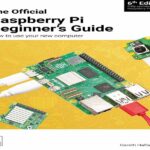- عنوان کتاب: Quantum Waveguide in Microcircuits
- نویسنده: Jian-Bai Xia
- حوزه: ریزمدارها
- سال انتشار: 2025
- تعداد صفحه: 433
- زبان اصلی: انگلیسی
- نوع فایل: pdf
- حجم فایل: 8.88 مگابایت
قرن گذشته، توسعه فناوری میکروالکترونیک نیمههادی، کل جهان را تغییر داد. جهان از جامعه صنعتی وارد جامعه اطلاعاتی شد. نیروهای تولیدی به شدت افزایش یافتند که این امر توسعه مواد انسانی و روح تمدن را ارتقا داد. درست به دلیل اهمیت فناوری میکروالکترونیک نیمههادی، بسیاری از دولتها و شرکتهای بینالمللی سرمایهگذاریهای زیادی در توسعه این فناوری انجام دادند، به این امید که بتوانند در توسعه کل فناوری اطلاعات پیشرفت کنند و جایگاه پیشرفتهای را به دست آورند. مدارهای مجتمع در سال ۱۹۵۸ اختراع شدند و در سالهای بعد، توسعه و پیشرفت در درجه ادغام تا حد زیادی از قانون مور پیروی کرده است. قانون مور قانونی است که توسعه فناوری و اقتصاد را برای پیشبینی درجه پیشرفت در ادغام مدارهای میکروالکترونیک در یک دوره مشخص ترکیب میکند. این قانون پیشبینی میکند که درجه ادغام ریزپردازندهها هر ۱۸ ماه در DRAM دو برابر میشود. قانون مور امروزه هنوز هم دقیق است. با این حال، با نزدیک شدن اندازه عناصر مدار به محدودیتهای فیزیکی خود، روش نوری مورد استفاده در ساخت تراشههای گره ۱۶ نانومتری نیز به یک حد نزدیک میشود. اگرچه مقیاسبندی عناصر مدار میکروالکترونیک هنوز از قانون مور پیروی میکند، اما چگالی واحد مصرف برق غیرقابل قبول خواهد شد. بنابراین، از یک سو، مردم به طور مداوم فناوری میکروالکترونیک را توسعه میدهند، در حالی که از سوی دیگر، مسیر توسعه پس از نقض قانون مور، یعنی بیشتر از قانون مور یا بیشتر از قانون مور را در نظر میگیرند. از نظر فیزیکی، وقتی مقیاس عنصر مدار به 10 نانومتر یا حتی کمتر کاهش مییابد، اثر کوانتومی ظاهر میشود و نقش فزایندهای ایفا میکند. انتقال الکترون غیرکلاسیکی و غیرخطی میشود و حتی حرکت الکترون مانند حرکت موجبر است. این کتاب از دو بخش تشکیل شده است: (1) انتقال غیرکلاسیکی و غیرخطی، و (2) نظریه موجبر کوانتومی. بخش اول به بررسی اثر تصحیح کوانتومی در دستگاههای فوق کوچک، از جمله انتقال میدان قوی و انتقال مربوط به فضا میپردازد (فصل 2). اثر مکانیک کوانتومی در انتقال طولی ابرشبکهها آشکارتر است زیرا طول طولی ابرشبکه حدود 10 نانومتر است که کوچکتر از مسیر آزاد میانگین الکترون است. انتقال کوانتومی شامل تونلزنی رزونانسی (فصل 3) و انتقال طولی یک ابرشبکه (فصل 4) است که در اوایل قرن هشتاد مشاهده شدند. به دلیل توسعه لیتوگرافی پرتو الکترونی در قرن نود، افراد میتوانند یک سیم فلزی فوق نازک را روی یک گاز الکترونی دوبعدی (2DEG) بسازند. اعمال ولتاژ بایاس بر روی یک اتصال فلزی میتواند یک نقطه کوانتومی کوچک در 2DEG زیر اتصال تشکیل دهد. لانداور و باتیکر در مطالعه انتقال نقاط کوانتومی و مدارهای نازک، فرمولهای معروف خود را که به نام آنها نامگذاری شده است، پیشنهاد کردند. این نوع انتقال، انتقال مزوسکوپی (فصل 5) نامیده میشود. افراد با استفاده از لیتوگرافی، نقاط کوانتومی سهبعدی را در جهت طولی یک چاه کوانتومی ساختند. نقطه کوانتومی در جهتهای بالا و پایین توسط موانع موجود در چاه کوانتومی اصلی محدود میشود و جهت جانبی آن به دلیل لیتوگرافی توسط خلاء محدود میشود. این نوع نقاط کوانتومی شبیه به یک اتم مصنوعی هستند که در آن الکترونها مطابق با پوسته پر میشوند. این ویژگی در انتقال کوانتومی، به عنوان مثال، انسداد کولمب (فصل 6) منعکس شده است. در نهایت، کاربردهای انتقال تک الکترونی را معرفی میکنیم: ترانزیستور تک الکترونی (فصل 7) و حافظه تک الکترونی (فصل 8). بخش دوم به بررسی نظریه موجبر کوانتومی، عمدتاً آثار خودمان، میپردازد. از زمانی که اثر آهارونوف-بوهم (اثر AB) به صورت تجربی توسط وب و همکارانش کشف شد، پیشرفتهای زیادی در انتقال سیستمهای مزوسکوپی صورت گرفته است. انتقال الکترون در سیستمهای مزوسکوپی از نوع انتشاری نیست، بلکه از نوع موجبری است زیرا در چنین سیستمهای کوچکی برخورد الکترونی وجود ندارد. انتقال از نوع موجبری ویژگیهای بسیاری متفاوت از نوع انتشاری دارد و روشهای تحقیق نظری این دو نوع نیز متفاوت است. اولی مبتنی بر مکانیک کوانتومی است، در حالی که دومی مبتنی بر فیزیک آماری کلاسیک: معادله بولتزمن است. در کاربرد، سیستمهای مزوسکوپی، به ویژه سیستمهای مزوسکوپی نیمههادی، اساس میکروالکترونیک نسل بعدی خواهند بود. این بخش خلاصهای از نتایج تحقیقات گروه ما در این زمینه در 20 سال گذشته را ارائه میدهد. فصل 9 مفهوم کلی انتقال کوانتومی را پوشش میدهد. فصل 10 به بررسی نظریه موجبر کوانتومی یک بعدی میپردازد که دو معادله اساسی مشابه معادلات کیرشهف در مدارهای الکتریکی ارائه میدهد. سپس دو معادله اساسی در بسیاری از موارد اعمال میشوند: حلقههای AB، دستگاههای تداخل کوانتومی و غیره. در نهایت، این نظریه به حالت سوراخ که تابع موج آن دارای دو مؤلفه است، تعمیم داده میشود. فصل 11 نظریه موجبر کوانتومی دو بعدی را شرح میدهد…
Last century, the development of semiconductor microelectronic technology changed the whole world. The world entered the information society from the industrial society. The productive forces rose greatly, which promoted the development of human material and the spirit of civilization. Just because of the importance of semiconductor microelectronic technology, many governments and international companies invested heavily in developing the technology, hoping to make a break through and occupy an advanced position in the development of the whole information technology. Integrated circuits were invented in 1958, and in subsequent years, development and progress in the degree of integration have largely followed Moore’s law. Moore’s law is a rule that combines technology development and economics to predict the degree of advancement in microelectronic circuit integration within a specified period. It predicts that the degree of microprocessor integration would double every 18 months in DRAM. Moore’s law is still proving accurate today. However, as the sizes of circuit elements approach their physical limits, the optical method used in manufacturing 16-nm-node chips is also approaching a limit. Although the scaling of microelectronic circuit elements still follows Moore’s law, the unit density of power consumption will become unacceptable. Therefore, on the one hand, people continuously develop microelectronic technology, while on the other hand, they consider the developing road after Moore’s law is broken, that is, more Moore’s law or more than Moore’s law. Physically, when the scale of the circuit element decreases to 10 nm or even less, the quantum effect will appear and play an increasingly important role. The electron transport becomes non-classical and non-linear, and even the electron motion likes the waveguide motion. This book consists of two parts: (i) non-classical, non-linear transport, and (ii) quantum waveguide theory. The first part discusses the quantum correction effect in ultrasmall devices, including strong field transport and transport related to space (Chapter 2). The quantum mechanics effect is most obvious in the longitudinal transport of superlattices because the longitudinal length of the superlattice is about 10 nm, smaller than the electron mean free path. Quantum transport includes resonant tunneling (Chapter 3) and longitudinal transport of a superlattice (Chapter 4), which were observed early in the last century eighties. Due to the development of electron beam lithography in the last century nineties, people can fabricate an ultrathin metallic wire on a two-dimensional electron gas (2DEG). Applying a bias voltage on a metallic contact can form a small quantum dot in the 2DEG underneath the contact. In studying the transport of quantum dots and thin circuits, Landauer and B¨ uttiker proposed their famous formulas named after them. This kind of transport is named mesoscopic transport (Chapter 5). People fabricated 3D quantum dots in the longitudinal direction of a quantum well by using lithography. The quantum dot is confined in the upper and lower directions by the barriers in the original quantum well, and its lateral direction is confined by vacuum due to the lithography. These kinds of quantum dots are similar to an artificial atom, in which the electrons are filled according to the shell. This characteristic is reflected in the quantum transport, for example, the Coulomb blockade (Chapter 6). Last, we introduce the applications of singleelectron transport: single-electron transistor (Chapter 7) and singleelectron memory (Chapter 8). The second part studies quantum waveguide theory, mainly our own works. Since the Aharonov–Bohm effect (AB effect) was experimentally discovered byWebb et al., there have been many advances in the transport of mesoscopic systems. Electron transport in mesoscopic systems is not of the diffusing type but of the waveguide type because there are no electron collisions in such small systems. Transport of the waveguide type has many characteristics different from those of the diffusing type, and the theoretical research methods of these two types are also different. The former is based on quantum mechanics, while the latter is based on the classical statistical physics: Boltzmann equation. In application, mesoscopic systems, especially semiconductor mesoscopic systems, will be the basis of next-generation microelectronics. This part summarizes the research results of our group in this field in the past 20 years. Chapter 9 covers the general concept of quantum transport. Chapter 10 discusses 1D quantum waveguide theory, which proposes two basic equations similar to Kirchhoff equations in electric circuits. Then the two basic equations are applied to many cases: AB rings, quantum interference devices, etc. Last, the theory is extended to the hole case, whose wave function has two components. Chapter 11 describes 2D quantum waveguide theory. When the width of the circuit is so large that the energy level spacing between the transverse modes in the circuit is comparable to the electron kinetic energy, we should consider the transport of multiple transverse modes, that is, 2D waveguide theory. In this chapter, the transfer matrix method, the scattering matrix method, and the theory of a waveguide with multiple terminals are developed. Chapter 12 discusses the 1D quantum waveguide theory of Rashba electrons. In recent years, much attention has been paid to the field of Rashba spin–orbit interaction (RSOI) in low-dimensional semiconductor structures because of its potential application in spintronic devices, which is based on the idea of the possible manipulation of electron spin by a magnetic or an electric field. Chapter 12 extends the 1D quantum waveguide theory of electrons without considering spin to the case of electrons with spin and RSOI, deriving the boundary conditions of the Rashba current. The theory is applied to study the transport of Rashba electrons in turning structures, spin-polarized devices, etc. Chapters 13 and 14 extend the 1D quantum waveguide theory of a Rashba electron in straight-line structures to curved-line structures. For this objective, the transfer matrix method is developed. With this method, the Rashba electron transport in the AB circular ring and square ring and related spin polarization modulation are studied. In Chapter 15, the 1D quantum waveguide theory of a Rashba electron is extended to the 2D case and some basic results are obtained. The second edition contains two new chapters as follows. Chapter 16 theoretically investigates, by using the transfer matrix method, Rashba electron’s spin transport in a straight waveguide with a stub which has a smooth boundary. Chapter 17 studies the spin transport of electrons in an elliptical ring with the Rashba spin– orbit interaction. It focuses on the spin flip in two kinds of rings and expects to find a suitable structure and conditions for a spin inverter. In summary, the transport theories and experiments beyond classical transport quantum waveguide are introduced, which are prepared for future semiconductor micro- and nanoelectronics. They will be the basis of next-generation semiconductor electronics and industry.We believe that these theories will have more and more applications, popularization, and developments.
این کتاب را میتوانید از لینک زیر بصورت رایگان دانلود کنید:
Download: Quantum Waveguide in Microcircuits




































نظرات کاربران